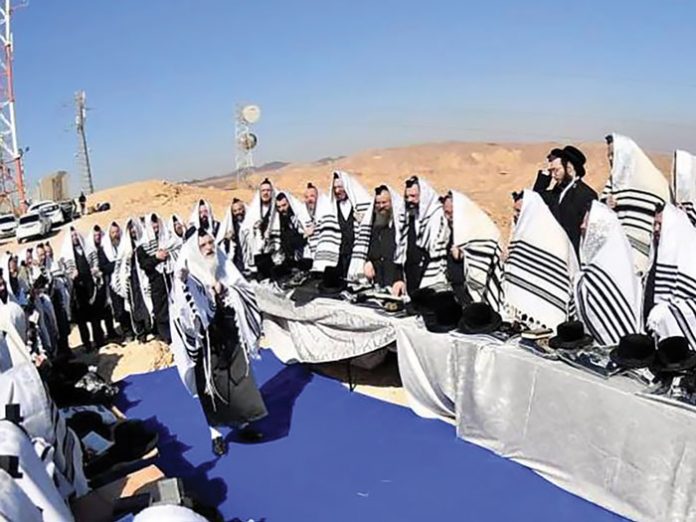Peek into a Closed Ultra-Orthodox Society
Vizhnitz Hasidic groups of the “Hager” family
 Ultra
Orthodox Jews from the Vizhnitz Hassidic Dynasty light candles on the
second night of the Jewish holiday of Hanukkah in Beit Shemesh on
December 7, 2015.
Ultra
Orthodox Jews from the Vizhnitz Hassidic Dynasty light candles on the
second night of the Jewish holiday of Hanukkah in Beit Shemesh on
December 7, 2015.
The various “courtyards” (synagogue communities) of ultra-orthodox/Haredi Judaism are growing and becoming an increasingly larger portion of the Israeli population, due high birth rates and their cloistered lifestyle. These streams are each led by charismatic senior rabbi leader called a “rebbe”. One of the streams is the “Vizhnitz” founded in Vyzhnytsia, a town in present-day Ukraine, in the early 1800s by Menachem Mendel Hager. Today, the Vizhnitzers number several thousand households in Israel.
In the Hasidic groups, upon the death of the Rebbe, one of his sons is chosen by the other rabbis and leaders of the community to serve as the successor and leader of the group. The other sons usually accept this appointment. Sometimes, however, there is a dispute, due to which a group withdraws and establishes a new community that competes with the original.
 In a historic trip in February 2020, the Vizhnitzer Rebbe, Rav Menachem Mendel Hager,
traveled with a group of about 65 chasidim to
recite Parshas HaMann in Egypt, overlooking the site where
the great miracles of Yetzias Mitzrayim occurred.
In a historic trip in February 2020, the Vizhnitzer Rebbe, Rav Menachem Mendel Hager,
traveled with a group of about 65 chasidim to
recite Parshas HaMann in Egypt, overlooking the site where
the great miracles of Yetzias Mitzrayim occurred.In Vizhnitz Hasidism, the principle was established already at the beginning, that all (male) descendants of the Rebbe are potential candidates to serve as leaders of a Hasidic court. Rabbi Ze’ev Wolff, one of the first Vizhnitz rebbes, stated: “May his rule be renewed, both over himself and over the souls of his household, and not depart from him and his sons and his sons’ sons forever.” Thus Vizhnitz Hasidism is a collective name for Hasidic courts with similar characteristics, under the leadership of various Rebbes.
The characteristics of Vizhnitz Hassidism are expressed in several areas:
Prayer – Vizhnitz followers usually pray enthusiastically using special intonations. During the prayers, the rebbe will sometimes walk among the worshipers to strengthen and encourage them to pray with intention and joy.
Love of Israel – a central goal in Vizhnitz Hasidism is trying to attract non-observant, “simple” Jews who do not observe Torah and oral commandments, and to bring together the different parts of the Jewish people. The “learners” are brought closer through tutorials and words of Torah, and those who are far from orthodox Judaism- through songs, melodies and pronouncing blessings over those who request a blessing. The love of Israel is also expressed by participating in the IDF unit called “Nahal” Haredi and recruitment into the IDF in the State of Israel. (Many Haredi groups refuse to serve in the general Israeli military conscription due to religious/ideological/cultural reasons.)
Torah study – In the Hasidic “courtyard,” a framework of study was established with Torah lessons, including the obligation to participate in a one-hour study schedule every evening in Hasidic midrash schools.
Shabbat – The Shabbat emphasis is related to their spiritual expression of joy. Special Sabbath tunes are central, and many of their teachings refer to Shabbat song lyrics.
Songs and chants – Vizhnitz Hasidim has developed a collection of hundreds of tunes that include Shabbat chants, prayers and verses from the Hebrew Bible. The tunes are catchy. Some of them have gypsy motifs that were popular among the Hasids in Eastern Europe.
The “anthem” of Vizhnitz hasidism is the tune Ya Ribon Olam (Yah – Lord forever/Lord of the world) – especially sung around the community table of the rebbe, in the format of a singer and choir. Yah Ribon Olam, is a song of prayer in Aramaic combining several melodies. Worshipers of Vizhnitz Hassidism have a way of singing it, which they say interprets the words of the prayer.
Clothing – on Shabbat, Vizhnitz followers usually wear white knee-high socks (as opposed to Belz followers who wear black socks). On the other days of the week, they wear long black pants. The members of the rebbe’s family usually wear black socks over their pants on weekdays.
Community Courts – Initially, the court was established to adjudicate in community matters, but over the years it also became a place to settle questions of religious practice, to which people from outside can come.
In addition, Vizhnitz Hasidism has educational institutions that include yeshivas for boys and seminaries for ultra-Orthodox girls from various communities.
The Vizhnitz Bakery – Challah bread for Shabbat. The saying that there is nothing like food to bring together those who are separated, surely refers to this Vizhnitz’s Shabbat delight. In Bnei Brak, an ultra-Orthodox city on the outskirts of Tel Aviv, Vizhnitz Hasids run a bakery that makes challah locally in honor of Shabbat. Even non-religious people eagerly purchase the delicious Vizhnitz challah bread on Thursdays and Fridays leading up to the Sabbath.
No comments:
Post a Comment